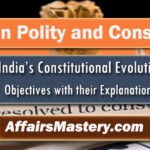Comprehensive Indian Constitutional Articles and Schedules MCQs | Set 2
Unlock Your Knowledge: Comprehensive and Important MCQs on Indian Constitution Articles and Schedules. Articles and Schedules plays a huge role in shaping Indian Polity and Governance, and it’s one of those things that really lays the groundwork for doing well in competitive exams—whether it’s Civil Services, State exams, SSC, Railways, Banking, or any of the others out there.
Diving deep into Indian Polity, Constitution, and governance isn’t just about memorizing facts or ticking boxes for exams, but more about developing the kind of awareness that can make navigating these challenging exams a little less overwhelming and a lot more manageable.
| MCQs on Indian Constitution Articles and Schedules – Objective Questions and Answers |

Q11. Which one among the following is NOT correctly matched ? (U.P. R.O./A.R.O. (Pre) (Re-Exam) 2016)
| Provision | Part of Constitution |
| A. Citizenship | Part II |
| B. The Union Territories | Part VII |
| C. Municipalities | Part IX-A |
| D. Elections | Part XV |
View Explanation
Correct Answer is B.
- “The Union Territories – Part VII” is wrong.
- Citizenship (Part II), Municipalities (Part IX-A), and Elections (Part XV) are all correct.
- But Union Territories fall under Part VIII, not Part VII.
Q12. Which part of our Constitution envisages a three tier system of Panchayats? (U.P. P.C.S. (Pre) 2013)
[A] Part IX
[B] Part X
[C] Part XI
[D] Part XII
View Explanation
Correct Answer is A.
- Part IX of the Constitution got added when the 73rd Amendment Act of 1992 came into effect, which basically set up this whole three-level Panchayati Raj system across the country.
- It’s got three parts to it—at the village level, block level, and district level—and it’s meant to make governance more local, giving people in rural areas more say in how things work around them.
- This section also spells out how these Panchayats are structured, who gets to be part of them, what kind of powers they hold, and what responsibilities they have.
Q13. Which part and chapter of the Indian Constitution deal with the legislative relation between the Union and the States? (U.P. P.C.S. (Mains) 2012)
[A] Part XI and Chapter I
[B] Part XI and Chapter II
[C] Part XII and Chapter I
[D] Part XII and Chapter II
View Explanation
Correct Answer is A.
- Part XI of the Indian Constitution is all about how the Union and the States are supposed to work together when it comes to making laws.
- It’s basically divided into two chapters—Chapter I covers legislative relations, meaning who gets to make laws on what subjects, and how conflicts between Union and State laws are handled.
- The other one, Chapter II, deals with administrative relations, which is more about how they coordinate their work.
- In Chapter I of Part XI, there’s this Union List, State List, and Concurrent List, which lay out who has the power to make laws on different subjects.
- If there’s ever a clash between State laws and Union laws, the Union law usually wins, unless the President has given special approval to a State law.
Q14. Which one of the following Schedules of the Indian Constitution lists the names of states and specifies their territories? (I.A.S. (Pre) 2003)
[A] First
[B] Second
[C] Third
[D] Fourth
View Explanation
Correct Answer is A.
The First Schedule of the Indian Constitution contains:
- Names of all States and Union Territories.
- Their territorial boundaries as defined in the Constitution.
Whenever new states are formed or existing ones are altered, this schedule is updated through constitutional amendments.
Important changes in this schedule happened through amendments like the States Reorganization Act of 1956, which reorganized state boundaries based on linguistic and administrative factors.
Q15. Which of the following are enshrined in the third schedule of the Indian Constitution? (U.P.P.C.S. (Pre) 2017)
1. Form of oath of office for a Minister for the Union.
2. Form of oath to be made by the Chief Justice of Supreme Court.
3. Form of oath of office for the President of India.
4. Form of oath to be made by a Member of Parliament.
Select the correct answer using the code given below: Code :
[A] 1, 2, 3
[B] 2, 3, 4
[C] 1, 2, 4
[D] 1, 2, 3, 4
View Explanation
Correct Answer is C.
The Third Schedule of the Indian Constitution contains the forms of oaths and affirmations for various important positions. These include:
- Form of oath of office for a Minister for the Union – This is included in the Third Schedule.
- Form of oath to be made by the Chief Justice of the Supreme Court – Also listed in the Third Schedule.
- Form of oath of office for the President of India – This is not a part of the Third Schedule; it is actually mentioned in the Second Schedule.
- Form of oath to be made by a Member of Parliament – This is included in the Third Schedule.
Q16. Fourth Schedule of the Constitution of India deals with (U.P.P.C.S. (Mains) 2015)
[A] Allocation of seats for the Council of States
[B] Political defection
[C] Panchayat system
[D] Languages
View Explanation
Correct Answer is A.
- The Fourth Schedule of the Indian Constitution deals with:
- Allocation of seats in the Council of States (Rajya Sabha).
- It specifies the number of seats each State and Union Territory can send to the Rajya Sabha.
- The allocation is based on the population of each State and Union Territory.
- This schedule ensures proportional representation for each State in the Rajya Sabha.
Q17. If a new state of the Indian Union is to be created, which one of the following Schedules of the Constitution must be amended? (I.A.S. (Pre) 2001)
[A] First
[B] Second
[C] Third
[D] Fourth
View Explanation
Correct Answer is A.
- When a new state is created in India, the following is amended:
- The First Schedule of the Constitution.
- This schedule contains the names of states and Union Territories along with their territorial boundaries.
- Any changes in the formation of new states or alteration of boundaries are reflected in this schedule.
Q18. Match List-I with List-II and select the correct answer from the code given below: (U.P.P.C.S. (Pre) 1999)
| Schedules of Constitution | Subject Matter |
| A. 4th | 1. Land Reforms |
| B. 6th | 2. Language |
| C. 8th | 3. Council of States |
| D. 9th | 4. Tribal Areas |
[A] A-1 B-2 C-3 D-4
[B] A-2 B-3 C-4 D-1
[C] A-3 B-4 C-2 D-1
[D] A-4 B-2 C-1 D-3
View Explanation
Correct Answer is C.
- 4th Schedule: Deals with the Council of States (Rajya Sabha) and the allocation of seats to states and Union Territories.
- 6th Schedule: Deals with the Tribal Areas in Assam, Meghalaya, Tripura, and Mizoram, providing for special provisions for the administration of these areas.
- 8th Schedule: Lists the Languages recognized by the Indian Constitution.
- 9th Schedule: Deals with Land Reforms and laws related to certain matters that are protected from judicial review.
Q19. Under which Schedule of the Constitution of India can be transfer of tribal land to private parties for mining be declared null and void? (I.A.S. (Pre) 2019)
[A] Third Schedule
[B] Fifth Schedule
[C] Ninth Schedule
[D] Twelfth Schedule
View Explanation
Correct Answer is B.
- The Fifth Schedule of the Indian Constitution deals with:
- Administration and control of tribal areas in certain states.
- Protection of tribal land from being transferred to private parties, especially for activities like mining.
- It provides for:
- Laws that can declare transfers of tribal land to non-tribals or private parties null and void.
- Safeguarding the rights and interests of the tribal communities.
Q20. Match List-I with List-II and select the correct answer from the code given below: (U.P.R.O./A.R.O. (Pre) 2016)
| Schedules of Constitution | Subject Matter |
| A. 7th | 1. Language |
| B. 8th | 2. Disqualification on ground of defection |
| C. 9th | 3. Distribution of legislative powers |
| D. 10th | 4. Validation of certain Acts |
[A] A-3 B-1 C-2 D-4
[B] A-2 B-3 C-4 D-1
[C] A-3 B-1 C-4 D-2
[D] A-4 B-2 C-1 D-3
View Explanation
Correct Answer is C.
- A. 7th → 3. Distribution of legislative powers: The Seventh Schedule deals with the division of powers between the Union and the States into three lists — Union List, State List, and Concurrent List.
- B. 8th → 1. Language: The Eighth Schedule lists the languages recognized by the Constitution of India.
- C. 9th → 4. Validation of certain Acts: The Ninth Schedule contains laws related to land reforms and other matters that are protected from judicial review, validating certain Acts.
- D. 10th → 2. Disqualification on the ground of defection: The Tenth Schedule deals with the provisions related to disqualification of members of Parliament and State Assemblies on grounds of defection (Anti-Defection Law).



